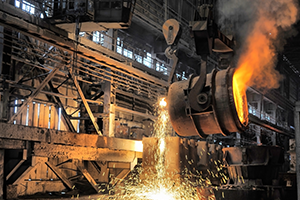The manufacturing industry and the metal producers such as the steel industry face transformational challenges that are amplified in the recent years. Before checking how AI will play a key role in offering new answers to deal with those challenges, let’s take a broad look at them and how they represent improvement opportunities and highlight the importance to act now.
Oversupply and metal prices collapse
The metal industry follows current market conditions, with demand increasing during economic booms and plunging during global recessions. Since China’s internal demand has dropped while the country maintains a huge production capacity, worldwide markets are flooded with an oversupply of steel, with major EU and US producers struggling to compensate for these cheaper imports. With around 50% of worldwide steel being produced in China, every other country must adapt to China’s demand and steel production.
Breaking even with reduced margins is increasingly hard for producers. Focusing on low-cost, high tonnage production is one possible strategy, while others gradually specialize in high quality production and specialized end products that increase returns per ton.
Lacking capital investments
Existing infrastructure and machinery, possibly outdated, cannot be easily replaced. Metal producers cannot afford to make large capital investment especially with global production overcapacity, and they must make do with what they already have and push it safely to its maximum efficiency.
Instability of production lines
Perturbations and instability along the production lines can decrease the yield, the quality and the lifecycle of machines, with the worst case being complete stoppage. This can be due to complex processes, variability in the raw materials, and aging machinery.
Process complexity
Production methods are getting increasingly complex, with interweaving processes that make tracking what really happens arduous and end-to-end optimization a herculean task for engineers. To reduce scrap, metal producers must find innovative ways to avoid defects and the reprocessing of materials.
Infrastructure costs
With expensive hourly costs of machines, production is struggling to achieve a high efficiency and optimizing the time it takes for tooling changes. Maximizing potential utilization of the production lines also depends on the stabilization and efficiency of processes.
Human resources
Attracting the brightest engineers and skilled operators is a sector-wide pain, with new professionals preferring high-income jobs in the service sector. Companies must find innovative ways to retain the knowledge and knowhow of previous generations of employees.
Safety challenges
Safety is a major concern across the manufacturing industry, and especially in large steelworks environments, to avoid accidents to workers, unintended dangerous emissions in the environment and production lines damages. With increased processes intricacies, companies are finding it exponentially difficult to predict critical issues in order to prevent them.
Environmental and regulatory challenges
Government initiatives such as the United Nations Framework Convention on Climate Change, the Paris Agreement, safety regulations and overall stricter norms are profoundly reshaping the manufacturing landscape, with a global pressure to curb CO2 emissions (to which the iron and steel industries contribute around 7% of global emissions), to reduce toxic greenhouse gases harmful to the environment and to make manufacturing processes more sustainable and clean.
Recycling and life-cycle
As high-grade raw materials resources are decreasing, recycling becomes essential to curb costs. Thankfully, compared to other materials, steel can be fully recycled to form new products that are the same or higher quality as the original material. An estimate of 85% of all steel products that reach the end of their life are thus recycled.
Integrating recycling into existing processes requires producers to dynamically adapt existing processes to the inherent changing quality of recycled materials, and to find ways to produce the same quality and quantity with less raw materials. This isn’t a painless transition, as lower quality materials typically increase energy usage, emissions and byproducts.


